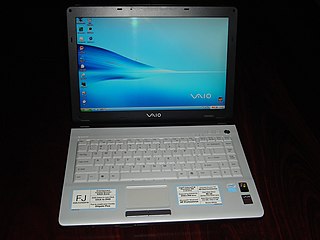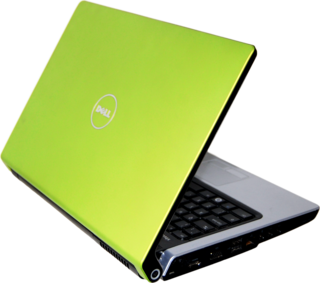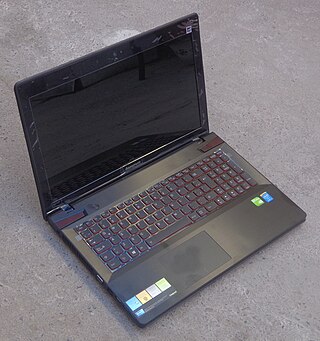
Dell XPS is a line of consumer-oriented high-end laptop and desktop computers manufactured by Dell since 1993. The XPS line's main competitors include Acer's Aspire, HP's Pavilion, Envy and Spectre, Lenovo's ThinkPad X1, Samsung's Notebook, Apple's MacBook Pro and Asus's ZenBook.

The Samsung Q1 was a family of ultra-mobile PCs produced by Samsung Electronics starting in 2007. They had a 7" (18 cm) LCD and were made in several different versions with either Windows XP Tablet PC Edition or Windows Vista Home Premium.

The Qosmio series was Toshiba's consumer-marketed line of high performance desktop replacement laptops. The laptop was first released on July 25, 2004 as the E15-AV101 with a 1.7 GHz Intel Pentium M CPU, 512 megabytes of DDR SDRAM, and a 15-inch XGA 1,024 by 768 screen. Toshiba's most powerful laptop has undergone many revisions, with focus shifting from high-end multimedia functionality to heavy gaming. The current line, the X70 series, was released in 2013, featuring an Intel Core i7 processor with up to 32 gigabytes of DDR3 SDRAM and an Nvidia GeForce GTX 770M as well as a 17.3-inch Full HD display.

The Sony Vaio FJ series is a 14.1-inch notebook designed for Windows XP and the FJ270, FJ290, FJ330,FJ370 models in particular, are designed for Windows Vista. The FJ Series uses only the Pentium M processors using the Sonoma platform of Intel Centrino.

Dell Vostro is a line of business-oriented laptop and desktop computers manufactured by Dell aimed at small to medium range businesses. From 2013–2015, the line was temporarily discontinued on some Dell websites but continued to be offered in other markets, such as Malaysia and India.

Dell's Studio brand is a range of laptops and desktops targeted in the mainstream consumer market. The computers sit above Dell's Inspiron and below the XPS consumer lines in terms of price and specifications. They differ from Dell's lower-end Inspiron models by offering slot-loading optical drives, media keys, more cover design options, faster processor options, HDMI and eSATA ports, LED-backlit screens and backlit keyboards.

HP TouchSmart is a series of tablet PC laptops and touchscreen all-in-one desktop computers designed by HP. It features various Intel or AMD processors and runs Windows Vista or Windows 7 as standard.

The Sony Vaio P series is a range of ultraportable subnotebook computers launched in January 2009.

Sony Vaio FW is a discontinued series of notebook computers which were the first laptops ever to have a 1080p 16.4" 16:9 widescreen LCD. Higher end models in the series can support an integral Blu-ray Disc reader or writer. The laptop weighed 3.1 kg. The battery lasts up to two hours. In June 2009, the ATI Mobility Radeon HD 3650 was replaced by the ATI Mobility Radeon HD 4650 with the release of the FW 4xx series. Additionally, Sony also released a special model of this series apart from the signature series models (Model:VGN-FW590FFD). This model had a futuristic themed cover and came equipped with moderately high-end specifications for $1069.99 U.S. dollars. The VGN-FW590FFD model was also only available for purchase through Sony Style's website.
Sony has used the Z model naming scheme for its high-end ultraportable notebook computers since 2000. Unlike other Sony models, the Z has always been manufactured in Japan or in the United States for some models. Sony has stated that production of the Z series will cease at the end of 2012.

The Vaio X series is a line of high-end ultraportable notebook computers from Sony introduced in September 2009, claiming to be the world's lightest notebook, at 655 grams ( ). It features an 11.1", 16:9, 1366x768 LED-lit LCD screen with built-in webcam, 2GB of DDR2 RAM, a choice of 64, 128 or 256 GB SSD, Intel Atom Z540 1.86 GHz or Z550 2.00 GHz, WWAN.
The Sony Vaio TT series was a line of high-end ultraportable notebook computers from Sony introduced in September 2008, with high-end features including an ultra-low voltage Core 2 Duo processor with DDR3 SDRAM; an 11.1", 16:9, 1366x768 LED-backlit LCD screen with built-in 0.3 megapixel webcam; choice of 1.8" hard drive or SSD ; and optional Blu-ray drive. The weight of the laptop is 1.3 kg.

The IdeaPad S Series is a series of notebook computers launched by Lenovo in October 2008. The IdeaPad S10 was initially scheduled for launch in September, but its release was delayed in the United States until October.

The IdeaPad Y series was a consumer range of laptops produced by Lenovo, first announced in 2008. They were marketed as premium high performance laptops for multimedia and gaming, as part of the IdeaPad line.
The A Series desktops are part of Lenovo’s ThinkCentre product line. Formerly an IBM brand, Lenovo acquired the ThinkCentre desktop brand following its purchase of IBM’s Personal Computing Division (PCD) in 2005. The first desktop in the A Series was the ThinkCentre A50p. Lenovo has released A Series desktops in multiple form factors, ranging from traditional tower, to small form factor, and all-in-ones (AIOs).
The M-series of desktops are part of Lenovo's ThinkCentre product line. Formerly an IBM brand, Lenovo acquired the ThinkCentre desktop brand following its purchase of IBM's Personal Computing Division (PCD) in 2005. Following its acquisition of IBM's PCD, Lenovo has released M-series desktops in multiple form factors, ranging from traditional tower, to small form factor, and all-in-ones (AIOs).
The IdeaCentre B Series all-in-one desktops from Lenovo were first launched in 2010. Like other desktops in the IdeaCentre product line, the B Series desktops were designed for home users, with a focus on the consumer PC segment. The first model in the series was the B500.
The IdeaCentre K series desktops from Lenovo are described by the manufacturer as being gaming-oriented desktops. Typical features on the desktops include mid-range to high-end processors, discrete graphics cards, multiple hard disk drives, multiple RAM DIMMS, multiple USB ports, and multiple optical disk drives. The K Series desktops also come with a physical switch on the CPU that allows users to shift between different levels of processing power. For example, the K330 offered red for high performance, blue for moderate performance, and green for less processing- and resource-intensive tasks.
In addition to the ThinkPad and IdeaPad laptops, Lenovo also offers a value-priced series of laptops. Called ‘Essential’ on the Lenovo website, the products available in this line include the G Series, B Series, and V Series. Launched in 2009, the first laptop in the Essential range was the G530.
Lenovo’s line of Essential desktops is a collection of budget-conscious machines designed for consumers, and advertised as being "affordable, space saving, and energy efficient". The Essential desktop line is different from both Lenovo’s ThinkCentre line and Lenovo’s IdeaCentre line. Lenovo defines its ThinkCentre desktops as business-oriented computers, while the IdeaCentre desktops are meant primarily for entertainment. The Essential range of desktops can be categorized as being between the two – meant more for ordinary everyday use.











